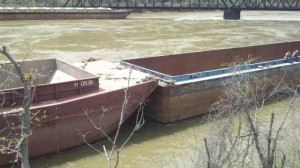In the early morning hours of April 27, 2011, four (4) barges broke free from the Carl L. Johnson, which is operated by Consol Energy. U.S. Coast Guard officials said the barges broke loose when a wire snapped as crewmembers were trying to face up (connect) to a barge. While it has not been reported, in my opinion, the high water conditions likely played a role in the barge breakaway.
One barge owned by Marathon Ashland was carrying coal tar light oil which contains benzene, a hazardous and highly flammable substance, while the other three barges were jumbo open-hopper barges carrying non-flammable loads. The chemical barge struck a railroad bridge near Neville Island and became lodged there along with another barge. A third barge carrying steel coils sank. The fourth barge carrying coal slag continued down the Ohio River until it struck the Emsworth Lock and Dam.
Fortunately, the U.S. Army Corps of Engineers in Pittsburgh was able to safely retrieve the chemical barge, with the help of several towing companies and their deckhands. Given the highly flammable and toxic elements in the chemical barge, the Fleming Park Bridge that connects Neville Island to Stowe Township was closed. Nearby elementary and middle school students were dismissed early as a precaution in case of an explosion during the barge removal. Specifically, officials were concerned that if the benzene ignited during the removal, the fumes –which contain carcinogens known to cause cancer and other respiratory problems – could affect the school populations.
During the retrieval of the chemical barge, crews of several towboats were clearly concerned about a potential explosion since they tied four other barges together end-on-end so they could reach the benzene barge and keep the motor vessels (known as towboats), which contain diesel fuel, as far as possible from the chemical barge. Then, with a tow boat stationed at the other end of the barges, the vessel and her crew guided the benzene barge to safety. The other two barges were rescued as well. However, before the Coast Guard can arrange for a salvage company to safely lift the sunken barge from the river bottom, the stage of the river must drop considerably from flood stage.
Those of us who are involved in maritime litigation on the inland waters of the United States know that high water or “flood” conditions often produce barge break-away situations that can sometime result in damage to property along the rivers aside from the damage to the runaway barge. Other times, deckhands or pleasure boaters are injured or killed.
The crew members aboard the Carl L. Johnson and other towboats involved in the rescue effort are called “deckhands.” A deckhand is an ordinary seaman who assists in transiting barges or other vessels along the navigable waters of the United States. The City of Pittsburgh and surrounding communities have considerable commercial maritime traffic aside from recreational boats (pleasure craft, jet-skis) given the Monongahela and Allegheny Rivers converge at the “the point” to create the Ohio River. The Port of Pittsburgh was recently ranked the fifth busiest inland port in the U.S. based on tonnage that moves through our area. Products such as coal, fuel, sand, gravel and steel, are moved in and out of southwestern Pennsylvania by towboats crewed by deckhands. The rivers provide a relatively inexpensively mode of transportation for these cargos.

